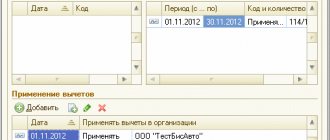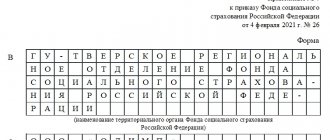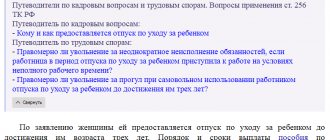Child care leave is provided upon application; it can be used in full or in parts: by the mother, father of the child, grandmother, grandfather, or other relative who actually cares for the baby.
Specific and to the point, always relevant: in the berator “Practical Encyclopedia of Accountants”
Holiday to care for the child
Leave is provided until the child reaches 3 years of age, and child care benefits are paid only up to 1.5 years.
About interruption of maternity leave in general
An employee on maternity leave can return to work at any time she wishes. It doesn’t matter how much time has passed since the birth of the child. But early exit can only occur at the request of the employee. The employer, for its part, must provide full leave and benefits, and does not have the right to demand that the employee start work earlier.
Maternity leave can be interrupted in two ways:
- The employee refuses it completely and goes back to work full time. In this case, benefits payments to her will cease.
- An employee can go to work part-time or work remotely. In this case, she will receive salary and benefits at the same time.
In the second case, there are several nuances regarding working conditions:
- An employee cannot be forced to work overtime or asked to work on weekends;
- No business trips;
- It is prohibited to transfer an employee to another position (promotion with the consent of the employee is possible, but demotion is not);
- An employee cannot be fired (even if there are good reasons for this).
Briefly
- An employee caring for a child under 3 years old can leave maternity leave earlier than the specified period. To do this, she should write an application for early termination of vacation. The consent of the company's management is not required.
- Working at a wage ahead of schedule means that she is not entitled to benefits paid until the child is 1.5 years old, and a reduced schedule and home work allow her to benefit from social support from the state in full.
- If a woman starts working ahead of schedule, any member of the child’s family can take leave instead.
Payment of benefits when working part-time
The FSS (social insurance fund) is responsible for benefits for women who have recently become mothers. And some entrepreneurs have problems in their relations with this organization.
The reason for these problems is that the Labor Code of the Russian Federation does not say exactly what is considered part-time work. If you study the code in detail, you can conclude that part-time work is time that is less than the established, normal working time. Those. Part-time work can be considered a situation where an employee works 7 instead of the normal 8 hours a day, or when an employee works 4 instead of 5 days a week (with a 5-day work week).
However, the Social Insurance Fund has a provision that says that working time is recognized as shortened only if it is less than the main one by at least 2 hours (i.e., with an 8-hour working day, the shortened working day should be no more than 6 hours).
There were several cases when the Social Insurance Fund refused to pay benefits because it called a reduction in time of an hour a full working day. There were lawsuits on this issue, and all of them were won by the companies, since the Labor Code of the Russian Federation is higher in value than the FSS Regulations. However, if you do not want to deal with the courts, it is best to reduce your working day by 2 hours. You will lose much more at trials than you will gain in this extra time, according to the FSS.
Is an employee who works during maternity leave entitled to annual leave?
A working woman during the period of leave under the UzR can write an application for the provision of annual leave entitled to her by law. This does not contradict the law, and, with the consent of the employer, it can be formalized in the following ways:
- The employee interrupts her UzR leave and goes on annual leave, at the end of which she can return to UzR leave again.
- An employee stops working part-time during maternity leave.
Thus, the employee will continue to receive benefits, and she will be given the opportunity to take annual leave after leaving maternity leave.
Algorithm for early termination of maternity leave with full-time work
Interrupting maternity leave is a fairly simple process in itself that does not require much paperwork.
Step 1. Submitting an application from an employee
This statement is written in free form. It must contain information that the employee wants to work full time (accordingly, she refuses to pay benefits), and the date on which she wants to begin her duties.
The deadline for filing this application is not established by law. Therefore, some difficulties may arise here. For example, if the company hired a temporary employee for this position while the employee was on maternity leave, and the woman wants to go to work the next day after submitting the application, the company simply will not have time to terminate the contract with the temporary employee. The employer has no right to refuse work or not accept an application. Therefore, it is best to draw up an internal regulatory document that will indicate within what time the application must be submitted.
Step 2. Issuing an order to return to work
This order also does not have a statutory form. But it must indicate the employer’s consent to interrupt the vacation, the date on which the employee begins duties, and information about the interruption of benefits and the calculation of wages in full.
The employee must sign this document.
Resumption of maternity leave
Maternity leave is divided into maternity leave (70 days before childbirth and 70 after) and child care leave. The latter is provided until the child is 3 years old, and can be interrupted and resumed at any time. For example, a mother can go to work for six months, and then apply again for maternity leave if the baby is under 3 years old.
Legal aspects and examples
Let's look at the procedure for early exit from parental leave using several typical examples.
Situation: the employee is going to leave maternity leave, which she informed the management about by writing a corresponding statement. The administration told her that there were no available jobs and offered her to resign.
Here the administration violated the provisions of Art. 256 of the Labor Code of the Russian Federation, which talks about guarantees of maintaining a job during parental leave. It is advisable to first identify the violation by contacting the labor inspectorate or the prosecutor's office with a request to verify the legality of the administration's actions, and then, guided by the collected materials, go to court.
Situation: the director informs an employee who is on maternity leave for up to 1.5 years that the company is being liquidated (the name is being changed), offers to leave the leave early, resign on her own initiative, and then come to work at a new company.
In this situation, leaving the vacation early and subsequent dismissal with the conclusion of a new employment contract is unprofitable for the employee. Renaming a company does not mean its automatic liquidation. In addition, dismissal during liquidation involves a number of guarantees and compensations, including for women on maternity leave.
Situation: a woman is caring for a child under 1.5 years old, is on vacation, and wants to terminate it early. Then the baby’s father, an employee of the same organization, is going to register it. Parents act within the framework of Art. 256 of the Labor Code of the Russian Federation, which talks about the possibility of using leave not only by the mother, but also by other relatives and parts. The mother must write a letter of resignation, and the father must write a letter of resignation. Based on these documents, personnel orders are issued and benefits are calculated.
Situation: a woman’s maternity leave is expiring for up to 1.5 years, she wants to continue using the leave by filling out an application and extending it to 3 years, but in fact she is going to start working earlier. If previously the employee wrote an application for leave for up to 1.5 years, now she needs to write a new one - up to 3 years, and then, having worked for the desired period, declare in writing that she is leaving the leave. Based on the application, a corresponding order is issued.
Algorithm for interrupting maternity leave with part-time work
The peculiarity here is that the maternity leave is not actually interrupted, and the mother continues to receive benefits.
Step 1. Application
It is compiled in exactly the same way as when going full-time. But it does not indicate the refusal of benefits and indicates the type of work - part-time or remote work.
Step 2. Agreement on the new operating mode
The new schedule is discussed with the employee. Moreover, according to the law, she herself has the right to choose what hours she will go to work. The employer has the right not to approve the chosen schedule only if it violates the rights of other employees.
If a worker wishes to perform work duties at home, there is also only one reason for refusal - the inability to perform this type of work at home. For example, if a young mother works as a salesperson in a store, she will not be able to request remote work. But if a woman is an office worker, a call center employee, etc., and at the same time she wants to work remotely while on maternity leave, the employer cannot refuse her this.
Based on the selected schedule, an appropriate agreement is concluded with the employee, which details the schedule and indicates the salary (which is paid in accordance with the amount of time worked).
Step 3. Order on the employee’s new regime
This order states the same thing as the agreement. This order is given to the employee against signature.
General information about the application, features of the document
If you need to draw up an application for early leave from maternity leave, read our tips and view a sample document, based on which you can easily draw up your own form.
First, let's give some general information. There is currently no uniform standard for such a statement. This means only one thing: you can write it in free form or, if the employer is ready to provide a document template, in its form.
Regardless of which option is chosen, when drawing up an application, do not forget a few general points that are typical for all such papers. For example, keep in mind that the structure and content of the form must comply with certain office work rules. That is, the statement should be divided into three parts:
- the beginning or, as they also say, the “header”, where data about the addressee and the applicant is entered,
- main block,
- conclusion.
The main block contains the actual request for early leave from maternity leave and some other important information, and the conclusion is the personal autograph of the maternity leaver.
The application can be written on a simple blank sheet of any suitable format (preferably A4), by hand or typed on a computer - this does not matter in determining its legitimacy. You should only ensure that it is compiled without errors and blots, and if any do occur, it is better not to correct them, but to create another form.
An application is drawn up in two equivalent copies ,
- one of which must be given to the employer,
- the second one, after it has been marked to accept the copy, keep it for yourself.
In the future, this will help to avoid possible disagreements with the employer if a question suddenly arises about the very fact of the existence of the application or the deadline for submitting it to its intended purpose.
How does the Labor Code regulate the issue?
While an employee is on maternity leave, the following could happen:
- the position was taken by a temporary employee whom the employer does not want to transfer to another position or dismiss;
- the division in which the employee worked before the maternity leave ceased to exist, that is, the staff was reduced, but the entire enterprise was not liquidated;
- the company was liquidated.
When a company is liquidated, any employee can be fired, including those on maternity leave. However, in all other cases, an employee on maternity leave cannot be fired. This rule is enshrined in Part 6 of Art. 81 Labor Code of the Russian Federation.
To transfer an employee who has returned from maternity leave to a new position or another job, his voluntary consent is required. Otherwise, he should be given his previous position. Dismissal can only be made for disciplinary violations.
At the same time, employees often forget that, by virtue of Art. 72.1 of the Labor Code of the Russian Federation, the employer can transfer them to another workplace in another unit in the same area. The main thing here is that the terms of the employment contract do not change. Employers take advantage of this condition if another permanent employee returns to work during maternity leave.
Let me give you an example from practice: before going on maternity leave, a woman worked as an administrator in a private medical clinic, which had two divisions located in two different buildings. After the child turned 3 years old, the woman decided to go to work.
The employer refused to give her her previous job, but offered her a job as an administrator in a nearby dental department. The woman didn’t want to work there: she didn’t like the fact that she would have to work with money. Since she did not show up for work, her employer fired her for absenteeism. The court recognized this as legal (see the decision of the Borovsky District Court of the Kaluga Court of January 30, 2019 in case No. 2-113/2019).
If at the time of maternity leave the position was reduced, then, according to Art. 81 of the Labor Code of the Russian Federation, the employee must be offered another job available to the employer, even if it is paid less. If he does not agree, he may be fired, and the employer, as in the case of liquidation of the company, must pay his former employee severance pay and support him financially during his employment.
According to Art. 180 of the Labor Code of the Russian Federation, an employee dismissed during liquidation or layoff has the right to receive his previous earnings for up to 3 months until he finds a new job. To receive payments for the 3rd month, you will have to register with the employment center immediately after dismissal.
Remember - when an employee returns from maternity leave, the employer cannot:
- not provide him with his previous job;
- transfer to another position without obtaining prior consent;
- suddenly and out of turn to recertify an employee returning from maternity leave.
If the employer cannot immediately provide the previous workplace, he must pay for the downtime. It is important here that the employee who has returned from maternity leave is at the enterprise or office during working hours. Absence may be counted as absenteeism and result in dismissal.
An interesting point: the position from which the employee went on maternity leave is not vacant at the enterprise. That is, she should not be offered to replace other employees who have been laid off. The courts pay attention to this (see the decision of the Pervomaisky District Court of Vladivostok dated February 13, 2019 in case No. 2-3072/2018).
In case of possible difficulties and obstacles on the part of the employer, you can file a complaint against him with the labor inspectorate. The regulatory authorities are on the side of the employee, so the employer will receive a warning about the need to comply with the requirement of the law or a fine under Art. 5.27 Code of Administrative Offenses of the Russian Federation. A fine can be imposed both on the company itself and on the director personally.
The liquidation of an enterprise is an exceptional case in which the contract is terminated without the consent of the employee, but a settlement must be made with the employee according to all the rules.
In practice, there may be no settlement if the company is subject to bankruptcy proceedings and there is no money in the accounts. But even in this case, debts to employees must be repaid over time.
Salary after maternity leave
During maternity leave, the employment conditions under the contract are maintained. Management has no right to cut salaries. The salary may even become a little higher due to the fact that a tax deduction will be made for children. The personal income tax deduction is provided to father and mother at their place of work. The tax deduction amount is 1,400 rubles. for the first and second child, for the third and each subsequent child the amount increases to 3,000 rubles.
To calculate the tax deduction, let's look at an example. Dad's salary is forty thousand rubles. From this amount, a personal income tax of 13% is paid to the budget. After a child appears in the family, tax will be calculated from the salary minus the deduction of 1,400 rubles, in fact from 38,600 rubles. When a second child appears in the family, 1,400 rubles will be deducted from the salary twice. At the birth of a third child, the amount of 3,000 rubles will be added to the tax deduction. Thus, monthly personal income tax will be charged on the amount of 34,200 rubles, and not on 40,000 rubles. salary
If the total annual salary of a parent reaches 350,000 rubles, the tax deduction will not be provided until next year. Both parents have the right to receive tax benefits for children - each at their place of work. If there is only one parent left in the family, and the second one is missing or died (or was not indicated on the birth certificate at all), the only parent can take out a double deduction. A mother raising a child alone has this right.
Employer actions in 2021
The assignment and payment of maternity benefits in 2021 is regulated by temporary rules from the Decree of the Government of the Russian Federation dated December 30, 2020 No. 2375. Now women receive such benefits directly from the budget of the Social Insurance Fund of the Russian Federation, bypassing the employer.
For 2021, the temporary rules stipulate that in order to recalculate the assigned benefit, the employee must submit an application to the employer and attach supporting documents. And the employer is obliged to transfer the received documents to the Social Insurance Fund office within five calendar days. Otherwise, the employer will be charged with failure to submit or untimely submission of documents affecting the calculation of the amount of benefits.
Timing of return to work after maternity period
The employee is given 140 days, after which she can be on UzR leave for another three years. The employee must return to her previously held position immediately after the child turns 3 years old. This can be done on any day, having previously notified the employer of your decision.
Features of the work routine of working mothers
- Women with children under one and a half years old.
Women who have just become mothers are provided with special working conditions
They can exercise the right to breaks during working hours to feed the child. The duration of such breaks should not be more than half an hour if there is one child, and one hour if there are two children. These breaks can be used regardless of the type of feeding. When calculating wages, feeding time is included in the payroll period.
When applying for a job, women in this category are not tested.
- Women with children under three years of age:
The right to refuse to work at night. Despite this, they can be involved in work on rest days, as well as on business trips.
Who to leave the child with
To return to the team, a woman needs to decide who the child will be with during this period. When the maternity leave ends when the child is three years old, this issue is easier to resolve. You can send your child to kindergarten. There is a nursery for younger children. But there are much fewer such groups, and there is a long queue. You need to occupy it early, literally after returning from the maternity hospital. The mother is obliged to build her routine in such a way that she takes the child to the kindergarten before work and takes her back in the evening. It will not be possible to work more than expected and stay late at work.
A working mother with a small child is always unpredictable. Children may suddenly catch a cold, and one of the parents will need to issue a sick leave certificate for this. Frequent sick leave reduces earnings or may leave the mother without a bonus. If only the mother or only the father takes time off when a child gets sick, the employer may be nervous because the employee is often absent from work. The solution to this situation may be “rotating parents.” For example, when only dad goes on sick leave in one month, in the second month this responsibility falls on mom.










